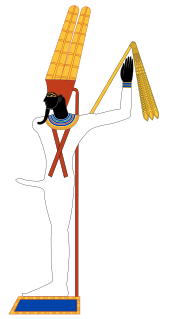
Min is an ancient Egyptian god whose cult originated in the predynastic period. He was represented in many different forms, but was most often represented in male human form, shown with an erect penis which he holds in his left hand and an upheld right arm holding a flail.
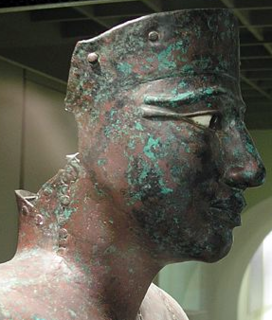
Pepi I Meryre was the third king of the Sixth Dynasty of Egypt, ruling for over 40 years during the second half of the 24th Century BC, toward the end of the Old Kingdom period. Pepi I was the son of his second predecessor Teti, ascending the throne only after the brief and enigmatic reign of the shadowy Userkare. Pepi's mother was queen Iput, who may have been a daughter of Unas, final ruler of the Fifth Dynasty of Egypt.

The Eleventh Dynasty of ancient Egypt is a well-attested group of rulers. Its earlier members before Pharaoh Mentuhotep II are grouped with the four preceding dynasties to form the First Intermediate Period, whereas the later members are considered part of the Middle Kingdom. They all ruled from Thebes in Upper Egypt.
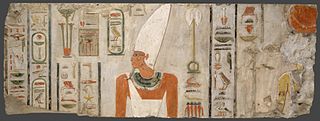
Mentuhotep II, also known under his prenomen Nephepetre, was an ancient Egyptian pharaoh circa 2061–2010 BCE, the sixth ruler of the Eleventh Dynasty. He is credited with reuniting Egypt, thus ending the turbulent First Intermediate Period and becoming the first pharaoh of the Middle Kingdom. He reigned for 51 years, according to the Turin King List. Mentuhotep II succeeded his father Intef III on the throne and was in turn succeeded by his son Mentuhotep III.
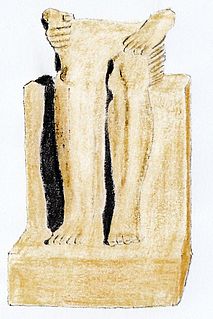
Mentuhotep I may have been a Theban nomarch and independent ruler of Upper Egypt during the early First Intermediate Period. Alternatively, Mentuhotep I may be a fictional figure created during the later Eleventh dynasty, which rose to prominence under Intef II and Mentuhotep II, playing the role of a founding father.

Qift is a small town in the Qena Governorate of Egypt about 43 km (27 mi) north of Luxor, situated under 26° north lat., on the east bank of the Nile. In ancient times its proximity to the Red Sea made it an important trading emporium between India, Punt, Felix Arabia and the North.It was important for nearby gold and quartzite mines in the Eastern Desert, and as a starting point for expeditions to Punt.

Nubkheperre Intef was an Egyptian king of the Seventeenth Dynasty of Egypt at Thebes during the Second Intermediate Period, when Egypt was divided by rival dynasties including the Hyksos in Lower Egypt. He is known to be the brother of Sekhemre-Wepmaat Intef—and this king's immediate successor—since he donated Louvre Coffin E3019 for this king's burial which bears an inscription that it was donated for king Sekhemre Wepmaat Intef "as that which his brother, king Antefgives", notes Kim Ryholt. As the German scholar Thomas Schneider writes in the 2006 book Ancient Egyptian Chronology :

Rahotep was an Egyptian pharaoh who reigned during the Second Intermediate Period, when Egypt was ruled by multiple kings. The egyptologists Kim Ryholt and Darrell Baker believe that Rahotep was the first king of the 17th Dynasty.

Sekhemre Wadjkhaw Sobekemsaf I was a pharaoh of Egypt during the 17th Dynasty. He is attested by a series of inscriptions mentioning a mining expedition to the rock quarries at Wadi Hammamat in the Eastern Desert during his reign. One of the inscriptions is explicitly dated to his Year 7. He also extensively restored and decorated the Temple of Monthu at Medamud where a fine relief of this king making an offering before the gods has survived.

Sekhemre-Heruhirmaat Intef was an ancient Egyptian king of the Seventeenth Dynasty of Egypt, who ruled during the Second Intermediate Period, when Egypt was divided between the Theban-based 17th Dynasty in Upper Egypt and the Hyksos 15th Dynasty who controlled Lower and part of Middle Egypt.

Sekhemre-Wepmaat Intef was an Egyptian king of the Seventeenth Dynasty of Egypt, who lived late during the Second Intermediate Period, when Egypt was divided into two by Hyksos controlled Lower Egypt and Theban ruled Upper Egypt.
Sekhemre Shedtawy Sobekemsaf II) was an Egyptian king of the Seventeenth Dynasty of Egypt who reigned during the Second Intermediate Period, when Egypt was ruled by multiple kings. His throne name, Sekhemre Shedtawy, means "Powerful is Re; Rescuer of the Two Lands." It is now believed by Egyptologists that Sobekemsaf II was the father of both Sekhemre-Wepmaat Intef and Nubkheperre Intef based on an inscription carved on a doorjamb discovered in the ruins of a 17th Dynasty temple at Gebel Antef in the early 1990s which was built under Nubkheperre Intef. The doorjamb mentions a king Sobekem[saf] as the father of Nubkheperre Intef/Antef VII--(Antef begotten of Sobekem...) He was in all likelihood the Prince Sobekemsaf who is attested as the son and designated successor of king Sobekemsaf I on Cairo Statue CG 386.

Neferkaure was a pharaoh of ancient Egypt during the First Intermediate Period. According to the Abydos King List and the latest reconstruction of the Turin canon by Kim Ryholt, he was the 15th king of the Eighth Dynasty. This opinion is shared by the egyptologists Jürgen von Beckerath, Thomas Schneider and Darell Baker. As a pharaoh of the Eighth Dynasty, Neferkaure's seat of power was Memphis and he may not have held power over all of Egypt.

Neferkauhor Khuwihapi was an ancient Egyptian pharaoh of the Eighth Dynasty during the early First Intermediate Period, at a time when Egypt was possibly divided between several polities. Neferkauhor was the sixteenth and penultimate king of the Eighth Dynasty and as such would have ruled over the Memphite region. Neferkauhor reigned for little over 2 years and is one of the best attested kings of this period with eight of his decrees surviving in fragmentary condition to this day.
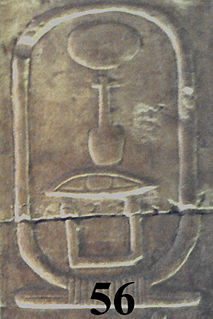
Neferirkare was an ancient Egyptian pharaoh of the Eighth Dynasty during the early First Intermediate Period. According to the egyptologists Kim Ryholt, Jürgen von Beckerath and Darrell Baker he was the 17th and final king of the Eighth Dynasty. Many scholars consider Neferirkare to have been the last pharaoh of the Old Kingdom, which came to an end with the 8th Dynasty.
Teti, Son of Minhotep, was an Egyptian official in Coptos during the reign of Pharaoh Nubkheperre Intef of the Seventeenth Dynasty of Egypt. His only clear attestation is in the Coptos Decree, which deprives him of his office and its stipend for some act of sacrilege. The exact nature of this crime is debated, largely due to the idiomatic or euphemistic language used in the text. Some have identified him as the same Teti who opposed Kamose several pharaohs later, which would indicate the pharaohs between Nubkheperre Intef and Kamose had very short reigns, but this identification remains problematic.
Articles related to ancient Egypt include:
Minemhat was the mayor of Koptos during the 17th Dynasty. Minemhat appears in three sources making him one of the best attested private individuals of the period and attesting that he was a highly influential person.
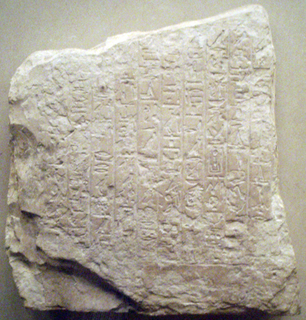
The Coptos Decrees are 18 complete or fragmentary ancient Egyptian royal decrees ranging from the 6th Dynasty to the late 8th Dynasty. The decrees are numbered with letters of the Latin alphabet, starting with "Coptos Decree a" and ending with "Coptos Decree r". The earliest of the series were issued by Pepi I and Pepi II Neferkare to favor the clergy of the temple of Min, while the others are datable to the reign of various kings of the 8th Dynasty, and concern various favors granted to an important official from Coptos named Shemay and to his family members. The decrees reflect the waning of the power of the pharaoh in the early First Intermediate Period.

Shemay was an ancient Egyptian official and later vizier toward the end of the 8th Dynasty during the First Intermediate Period, mainly known for being the beneficiary of most of the Coptos Decrees. His career has been interpreted as a glaring sign of the extreme weakness of the central power, forced to bestow great privileges to maintain the loyalty of powerful local governors. Shemay is buried in a mudbrick mastaba just south of Coptos.















